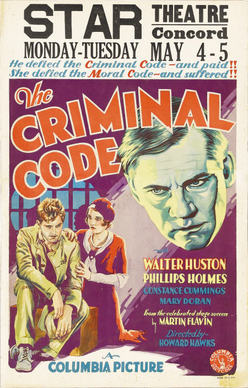 Directed by Howard Hawks and released by Columbia Pictures in 1931, The Criminal Code bears a few marked similarities to The Big House, a film released by rival studio MGM the year before. Both films follow the story of an otherwise good fellow who is convicted of an accidental killing while under the influence of alcohol, both films attempt to illustrate the brutal conditions of American prisons, and both films feature highly improbable romantic subplots. Only one of these films, however, has Walter Huston.
Directed by Howard Hawks and released by Columbia Pictures in 1931, The Criminal Code bears a few marked similarities to The Big House, a film released by rival studio MGM the year before. Both films follow the story of an otherwise good fellow who is convicted of an accidental killing while under the influence of alcohol, both films attempt to illustrate the brutal conditions of American prisons, and both films feature highly improbable romantic subplots. Only one of these films, however, has Walter Huston.In The Criminal Code, Walter Huston plays hard-nosed D.A. Martin Brady, who pursues a ten-year sentence for Robert Graham (Phillips Holmes), who accidentally killed a man in an altercation in a nightclub. Fast forward six years, and Brady is installed as the warden in the same prison where Graham has been serving his sentence. The horrendous conditions in the prison have taken their toll on Graham, who has begun to break down. On the recommendation of the prison doctor, Brady takes Graham out of the juke mill and takes him a his personal chauffeur. It is in that capacity that Graham meets Mary -- Brady's daughter, played by Constance Cummings. Romance ensues, but the situation is complicated when Graham witnesses the murder of a stool-pigeon by his cell-mate Galloway (Boris Karloff). Brady -- along with several guards -- finds Graham with the body, and Graham is compelled to choose between his saving his own skin or becoming a stool-pigeon himself.
The Criminal Code is dominated from beginning to end by Walter Huston, who gives a dynamic and lively performance. Huston truly deserves to be counted among the best actors of his era, and his work in this picture is good evidence of that claim (to say nothing of Dodsworth, Rain and a host of other pictures I ought to see). Although his part is comparatively small, Boris Karloff is also good here, being suitably menacing as the convict with a score to settle.
On the other hand, Phillips Holmes and Constance Cummings are comparatively lukewarm in their roles. Furthermore, their romantic subplot does seem more than a little improbable, although this does not detract too much from the film as a whole.
The Criminal Code is an example of an early talking picture that truly benefits from great direction -- the common complaints of static camera work and stiff acting really don't apply here, and I'll wager that the direction of Howard Hawks can be credited for that. It isn't without its drawbacks, but nevertheless it's definitely one worth checking out.
No comments:
Post a Comment